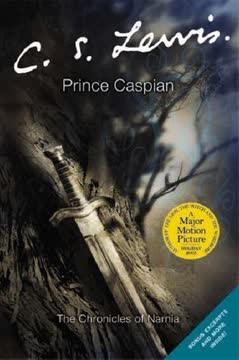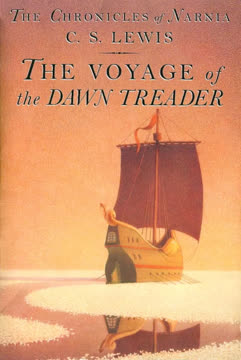Plot Summary
Fisherman's Son, Secret North
Shasta, a poor boy raised by the gruff fisherman Arsheesh in Calormen, dreams of the mysterious North, sensing he doesn't belong in his southern home. When a visiting Tarkaan offers to buy him, Shasta overhears he is not Arsheesh's real son but a foundling. This revelation, combined with the Tarkaan's cruelty, propels Shasta to consider escape. His chance comes when he discovers the Tarkaan's horse, Bree, is a talking Narnian horse longing for freedom. Bree proposes they flee together to Narnia, where both hope to find true belonging and freedom.
Bree's Proposal, Night Escape
Bree and Shasta form a partnership, each needing the other to escape. Bree, wise and proud, instructs Shasta in riding and survival, while Shasta's innocence and courage complement Bree's experience. They set out under cover of darkness, cleverly covering their tracks. Their journey is filled with new sensations—freedom, fear, and the unknown. Bree's tales of Narnia inspire Shasta, and their bond deepens as they face the first of many dangers, including the ever-present threat of being caught and the wildness of the world beyond their old lives.
Meeting Aravis and Hwin
Their journey is interrupted by a nighttime encounter with another pair: Aravis, a runaway Calormene noblewoman fleeing an unwanted marriage, and her gentle talking mare, Hwin. After a tense introduction, the four realize their goals align and agree to travel together. Aravis's resourcefulness and Hwin's quiet wisdom add new strengths to the group. They share their stories, revealing themes of oppression, courage, and the longing for a better life. Together, they plan to cross the great city of Tashbaan, the last barrier before the desert and freedom.
Disguises and Tashbaan Intrigue
To pass through Tashbaan, the group disguises themselves as peasants and pack animals. The city's splendor and chaos overwhelm Shasta, but the plan unravels when he is mistaken for Prince Corin of Archenland by visiting Narnians. Separated from his friends, Shasta is swept into Narnian political intrigue, learning of Queen Susan's refusal to marry Prince Rabadash and the Narnians' urgent need to escape the city. Meanwhile, Aravis is recognized by an old friend, Lasaraleen, and is forced to hide, inadvertently overhearing a secret council that reveals Rabadash's plan to invade Archenland and Narnia.
Mistaken Prince, Narnian Plots
Shasta, mistaken for the missing Prince Corin, is treated with kindness but is trapped by the Narnians' plans. He learns of their peril and their clever scheme to escape Tashbaan by sea. The real Corin returns, and the boys switch places, allowing Shasta to slip away. The experience leaves Shasta with a sense of unworthiness and confusion about his true identity, but also with vital knowledge: Rabadash's army is about to attack, and only he and his friends can warn Archenland in time.
Tombs, Lions, and Waiting
Shasta escapes the city and waits anxiously at the haunted Tombs for his companions. Alone and frightened by the city's closing gates and the howls of wild beasts, he is comforted by a mysterious cat who keeps him safe through the night. The next day, Aravis and the horses arrive, and the group is reunited. Aravis shares the urgent news of Rabadash's impending attack, and they set out across the desert, racing against time and exhaustion.
Aravis's Perilous Palace Eavesdropping
Aravis, hiding in the palace with Lasaraleen, overhears Prince Rabadash, the Tisroc, and the Grand Vizier plotting a surprise attack on Archenland and Narnia. The plan is ruthless: a swift, secret strike to capture Queen Susan and conquer the North. Aravis's courage and quick thinking allow her to escape and warn her friends, but not before she witnesses the cold, calculating nature of Calormene power and the personal cost of her own rebellion.
Rabadash's Treacherous Plan
Aravis and the others, now aware of the imminent threat, push themselves to the limit to cross the desert and warn King Lune of Archenland. The journey is grueling, marked by thirst, fatigue, and the relentless pursuit of Rabadash's army. The group's unity is tested, but their shared purpose drives them forward. The desert crossing becomes a crucible, forging their characters and deepening their bonds.
Desert Crossing, Race Against Time
The desert crossing is brutal. The group battles exhaustion and the elements, with only a narrow lead over Rabadash's forces. As they near Archenland, they are attacked by a lion—later revealed to be Aslan—who wounds Aravis and drives the group to the safety of the Hermit's house. Shasta, urged by the Hermit, must run alone to warn King Lune, pushing past his own limits in a final act of selflessness.
The Hermit's Sanctuary
The Hermit of the Southern March tends to Aravis's wounds and cares for Bree and Hwin, who are physically and emotionally spent. Bree, in particular, is humbled by his fear and failure to protect his friends, while Aravis reflects on her own pride and the consequences of her actions. The Hermit's wisdom and kindness provide a safe haven, allowing the characters to rest and confront their inner struggles.
Shasta's Lonely Journey, Aslan's Revelation
Shasta's desperate run through the mountains is marked by loneliness and self-pity, but he is joined by a mysterious presence—Aslan himself. Aslan reveals that he has been guiding and protecting Shasta all along, orchestrating events for a greater purpose. Shasta learns that his suffering and trials were not meaningless, and that he is not alone. This encounter transforms Shasta, giving him courage and a sense of destiny.
Narnian Allies, Battle Approaches
Shasta reaches King Lune and delivers the warning just in time. He is swept up by the warmth and camaraderie of the Archenlanders and Narnians, including King Edmund and Queen Lucy. The armies unite, and Shasta, still unaware of his true heritage, finds himself at the heart of a coming battle. The sense of belonging and purpose he has longed for is finally within reach.
The Siege of Anvard
Rabadash's forces besiege Anvard, but the combined might of Archenland and Narnia arrives in time. Shasta and Prince Corin, now revealed as twins, both participate in the battle. The fighting is fierce, but the defenders prevail. Rabadash is captured in a humiliating fashion, and the threat to the North is ended. The battle tests every character, revealing courage, loyalty, and the cost of pride.
Rabadash's Humiliation and Judgment
Rabadash, defiant and unrepentant, is brought before Aslan and the kings. Aslan offers him mercy, but Rabadash's pride leads to his transformation into a donkey—a punishment that is both just and redemptive. Rabadash's fate serves as a warning against arrogance and the refusal to accept grace. The episode closes the cycle of conflict and sets the stage for reconciliation and new beginnings.
True Identities, New Beginnings
Shasta is revealed to be Prince Cor, the long-lost heir of Archenland and twin brother to Corin. His true parentage and the prophecy of his destiny are fulfilled. Aravis is welcomed into the royal household, and Bree and Hwin prepare to enter Narnia as free horses. The characters find the homes and families they have sought, and the wounds of the past begin to heal.
Bree's Humbling, Aslan's Wisdom
Bree, once proud and self-assured, is humbled by his experiences and by a direct encounter with Aslan. He learns that true greatness lies in humility and service, not in pride or status. Aravis, too, is confronted with the consequences of her actions and is offered forgiveness and a new start. Aslan's presence brings healing, wisdom, and a sense of peace to all.
Reunions, Forgiveness, and Homecoming
The story concludes with joyful reunions, celebrations, and the promise of a bright future. Cor and Aravis eventually marry and rule Archenland wisely. Bree and Hwin find happiness in Narnia. The bonds formed through hardship endure, and the lessons of courage, humility, and grace shape the lives of all. The journey from slavery and fear to freedom and belonging is complete.
Characters
Shasta / Cor
Shasta begins as a humble, mistreated boy, uncertain of his origins and longing for a place where he truly belongs. His journey is both physical and psychological, marked by fear, courage, and self-doubt. Through trials, he discovers his true identity as Prince Cor, heir to Archenland, fulfilling a prophecy and finding the family and home he always desired. Shasta's development is shaped by his encounters with danger, friendship, and ultimately Aslan, who reveals the meaning behind his suffering and guides him toward maturity and leadership.
Bree
Bree is a talking Narnian horse, once enslaved and forced to hide his true nature. He is proud, experienced, and sometimes vain, but his journey exposes his vulnerabilities and fears, especially when confronted by real danger. Bree's arc is one of humility—learning that true nobility is not in pride or appearance, but in courage, honesty, and service. His relationship with Shasta and the others, and his encounter with Aslan, lead him to a deeper understanding of himself and his place in the world.
Aravis
Aravis is a Calormene aristocrat fleeing an arranged marriage and the constraints of her society. Intelligent, resourceful, and initially haughty, she is forced to confront her own prejudices and the consequences of her actions, especially when Aslan wounds her as a lesson in empathy. Through hardship and friendship, Aravis grows in compassion and humility, ultimately finding acceptance and love in Archenland, where she becomes a wise and just queen.
Hwin
Hwin is a talking mare, gentle and unassuming, but possessing deep wisdom and courage. She often serves as the voice of reason and humility among the group, encouraging unity and perseverance. Hwin's quiet faith and loyalty are instrumental in the group's survival, and her character demonstrates the power of gentleness and steadfastness in the face of adversity.
King Lune
King Lune of Archenland is a model of benevolent leadership—jovial, wise, and compassionate. His joy at the return of his lost son, Cor, and his fair judgment of enemies and friends alike, set the tone for the kingdom's values. Lune's warmth and humility contrast with the pride and cruelty of Calormene rulers, embodying the ideals of Narnian and Archenlandish society.
Prince Corin
Corin, Shasta's twin, is adventurous, bold, and sometimes reckless. His mistaken identity with Shasta drives much of the plot's confusion and eventual revelation. Corin's loyalty and courage are matched by his mischievousness, and his acceptance of Cor as heir demonstrates generosity and a love for freedom over power.
Prince Rabadash
Rabadash, heir to the Calormene throne, is driven by pride, desire, and a sense of entitlement. His pursuit of Queen Susan and his invasion of the North are motivated by wounded ego and ambition. Rabadash's refusal to accept mercy leads to his transformation into a donkey by Aslan—a punishment that exposes the folly of pride and the possibility of redemption through humility.
Aslan
Aslan, the great Lion, is the spiritual heart of the story—guiding, protecting, and challenging each character according to their needs. He appears in many forms, sometimes terrifying, sometimes comforting, always purposeful. Aslan's interventions reveal the deeper meaning behind suffering and the interconnectedness of each character's journey. He embodies justice, mercy, and the mysterious workings of providence.
The Hermit of the Southern March
The Hermit provides sanctuary, healing, and counsel to the weary travelers. His magical pool allows him to observe distant events, and his wisdom helps Bree, Aravis, and Hwin process their experiences. The Hermit's role is that of a mentor and safe haven, facilitating reflection and growth.
Lasaraleen
Lasaraleen, Aravis's old friend, is a foil to Aravis's seriousness—shallow, fashion-obsessed, but ultimately helpful. Her connections and willingness to help, despite her self-absorption, enable Aravis to escape Tashbaan and overhear the crucial plot against the North.
Plot Devices
Mistaken Identity and Disguise
Mistaken identity is central—Shasta is confused for Prince Corin, leading to his entanglement with the Narnians and eventual discovery of his true heritage. Disguises and false appearances are used repeatedly, both to escape danger and to explore deeper questions of identity and belonging. These devices create suspense, irony, and ultimately catharsis as true identities are revealed.
Prophecy and Destiny
The prophecy concerning Shasta/Cor's role in saving Archenland underpins the narrative, guiding characters toward their destinies even when they are unaware. The sense of a larger purpose, orchestrated by Aslan, gives meaning to suffering and struggle, and challenges characters to rise above their circumstances.
Divine Intervention and Foreshadowing
Aslan's presence is felt throughout, often in disguise or through indirect means. His interventions—appearing as a lion, a cat, or a voice—foreshadow later revelations and provide both protection and challenge. The narrative structure uses these moments to build suspense and to reveal the spiritual dimension underlying the adventure.
Parallel Journeys and Character Growth
The story's structure mirrors the characters' internal development: as they travel from slavery to freedom, from ignorance to knowledge, they are transformed. The parallel journeys of Shasta, Aravis, Bree, and Hwin allow for contrasting perspectives and mutual growth, culminating in reconciliation and new beginnings.
Analysis
C.S. Lewis's The Horse and His Boy is a tale of identity, courage, and the search for belonging, set against the backdrop of a classic adventure. Through the intertwined journeys of Shasta, Aravis, Bree, and Hwin, Lewis explores themes of providence, humility, and redemption. The narrative challenges the notion of fate as mere chance, instead presenting suffering and hardship as purposeful steps toward self-discovery and fulfillment. Aslan's role as a divine guide underscores the story's spiritual dimension, suggesting that every life is part of a greater story known only to its author. The book critiques pride, prejudice, and the abuse of power, contrasting the oppressive, hierarchical society of Calormen with the freedom and equality of Narnia and Archenland. Ultimately, the story affirms that true nobility lies not in birth or status, but in character, compassion, and the willingness to serve others. The lessons of forgiveness, humility, and the transformative power of grace resonate as deeply today as they did at the time of writing, making this a timeless parable of hope and homecoming.
Last updated:
Review Summary
The Horse and His Boy receives mixed reviews. Many praise its adventurous storyline and memorable characters, particularly Shasta and Aravis. However, numerous readers criticize its portrayal of the Calormenes, citing racist stereotypes and orientalism. Some find the pacing slow and the narrative less engaging than other Narnia books. Fans appreciate Lewis's writing style and moral lessons, while others feel the religious allegory is heavy-handed. The book's placement in the series chronology and its departure from the Pevensie siblings' perspective are points of contention among readers.
The Chronicles of Narnia (Chronological Order) Series
Similar Books










Download PDF
Download EPUB
.epub digital book format is ideal for reading ebooks on phones, tablets, and e-readers.













